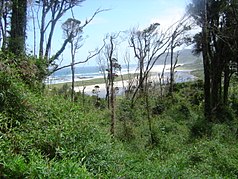Chiloe National Park
| Chiloe National Park | ||
|---|---|---|
| Chiloe National Park near Abtao | ||
|
|
||
| Location: | Región de los Lagos , Chile | |
| Next city: | Castro | |
| Surface: | 430 km² | |
| Founding: | 1983 | |
The Chiloé National Park (Spanish: Parque Nacional Chiloé ) is 43,057 hectares and is located in Chile in the Región de los Lagos . The national park is located on the island of Chiloé in the municipalities of Ancud , Dalcahue , Castro and Chonchi .
geography
The national park is located in the west of the island, roughly level with the capital of the island of Castro . The entrance to the national park with the town of Cucao lies on the Pacific . This is where the long Bahia Cucao beach is located .
The national park is divided into three areas and has a total area of 430 km²:
- Anay 352 km²
- Chepu 78 km²
- Islote Metalqui island 0.5 km²
The beaches on the Pacific have many dunes and are very popular with bathing tourists. Inside there are large pine forests and tepu trees. However, the weather on Chiloé is very rainy and changeable. The best time to visit the park is between September and March.
history
The island was inhabited by the Huilliche Indians long before the Spaniards . The Spaniards first set foot on the island in 1553 and founded the city of Castro in 1567 . Even after Chile became independent, the island remained in Spanish hands. It was not until 1826 that the Chileans took full possession of the island.
In 1834 Charles Darwin visited the island. The national park was established from 1983. At and in the national park there are still two Huilliche settlements: Huentemo and Chanquín.
fauna
The wildlife of the Chiloé National Park consists mainly of birds and marine mammals. More than 100 different animal species live in the park.
Penguins can be seen on the coast . There is a large colony of sea lions (Otaria flavescens) on the island of Metalqui, which can only be entered with a special permit.
Land mammals are less common in the park. The pudu (Pudu puda), one of the smallest deer on earth, and the endangered Chiloe fox ( Pseudalopex fulvipes ) live in the forest . The southern river otter ( Lutra provocax ), which feeds on fish and molluscs, occurs at the estuaries .
Infrastructure
In Cucao and its district of Chanquín, restaurants and accommodation are available for tourists. Local guides offer tours. You can also rent horses and boats. From Chonchi and Castro there are bus connections to Cucao several times a day, and occasionally to Chanquín. The buses run to the bridge over the Río Cipresal, which was newly built in 1998.
Between Cucao and Chanquín, a small museum has been set up on the park administration's property, from where a 710 m long forest nature trail ( Sendero educativo "El Tepual" ) leads through part of the park.
hiking map
A current hiking map is available in Castro at the CONAF information office, a little west of the Plaza de Armas or at the entrance to the national park.
Individual evidence
- ↑ Jorge Sánchez R .: Chiloé - tradición y cultura , p. 46. Santiago de Chile 2006. ISBN 956-309-024-1
- ↑ Juan Mancilla Pérez: Pueblos de Chiloé , p. 62. Castro 2008
- ↑ Juan Mancilla Pérez: Pueblos de Chiloé , p. 63. Castro 2008

